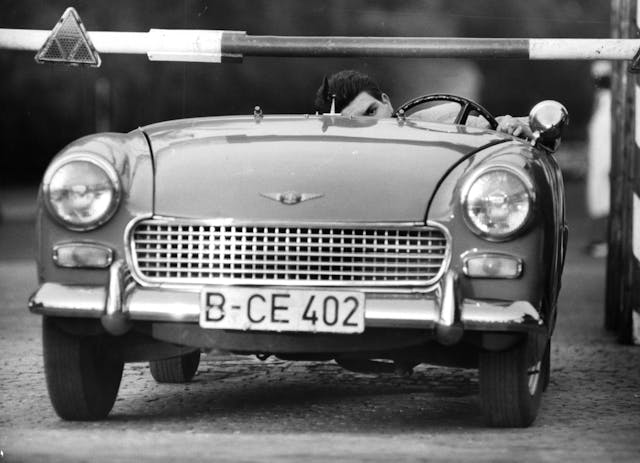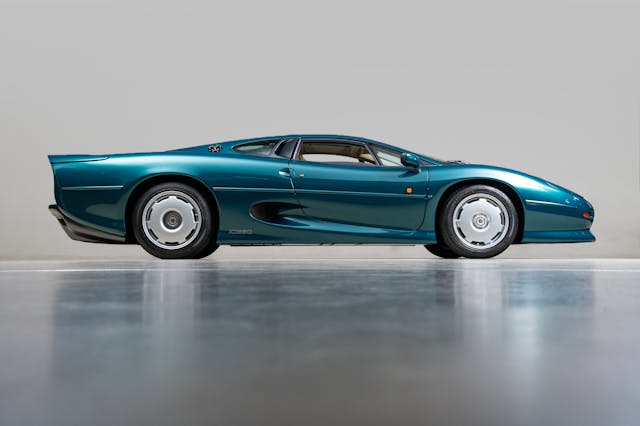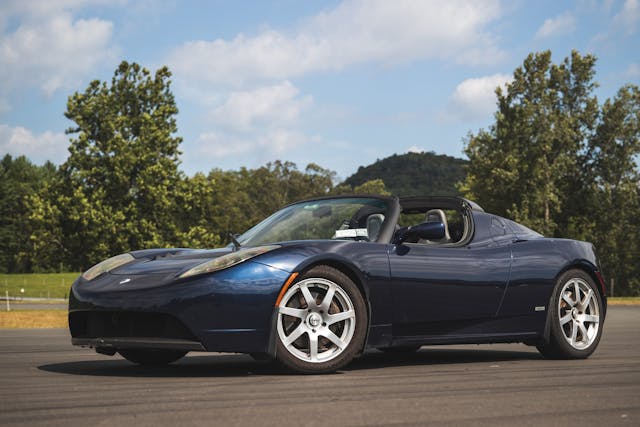5 Rides That Stumbled Last Quarter
We’ve discussed some of the notable gainers in the latest Hagerty Price Guide (we update it quarterly), but the fact remains that the market has continued to soften this year. We continue to see it in the Hagerty Market Rating, and many vehicles in the Hagerty Price Guide dropped as well. Much like the winners we highlighted a few weeks ago, the notable drops in our price guide are varied and come from across all segments of the hobby. Let’s dive in.
As always, if you have questions about how we arrived at these changes, you can read more about the methodology behind the Hagerty Price Guide here.
1954-57 Jaguar XK 140: -12%

Following the success of Jaguar’s first postwar sports car—the XK 120—the first update to the platform came in the form of the XK 140 in 1955. While it retained the race-proved 3.4-liter straight-six engine from the XK 120, it received a mild bump in power as well as quite a few cosmetic updates. In the Jaguar hierarchy, these are usually regarded as a bit less “pure” than the previous XK 120 but a bit less distinctive than the later, more refined XK 150, so a middle child effect exists and values reflect that.
The XK 140 experienced a steady period of growth from 2021 on, growing by 24-percent up until its peak in spring of 2023, however it is just now that we are seeing these gains start to walk back. Over the early part of this year, good quality cars started selling for much lower values than we’ve seen in nearly two years. While the sky isn’t falling and these are still valuable cars (the median condition #2 value is $110K), we are watching the market closely on these going into the Monterey auctions to see what happens.
1962-69 Austin-Healey Sprite: -11%

While already cheap and cheerful, the Austin-Healey Sprite (also sold as the Midget in MG form) just got a little cheaper. Small, British sports roadsters have always been a great way to enter the hobby. Many of the best ones still run less than $20,000 and if you’re pressed for room, they’ll fit in a one-stall garage with tons of space to spare. The best part is that if you’re somewhat mechanically inclined, the operating systems and the agricultural nature of the Sprite and its A-Series engine present a simple way to DIY repairs without too much trouble. If you want something as beginner friendly on the wallet and ownership experience as a Miata, but you want something more classical, then it’s hard to ignore the Sprite.
Cheap vehicles have also seen some of the most surprising growth over the past few years. Given the abundance of both Sprites and Midgets along with their inexpensive nature, then, an 11 percent drop here is something worth noting. In pure dollar terms the decrease isn’t much (the median #2 value is $13,200) and 1962-69 Sprites are now worth about what they were three years ago. Square-body Sprites (not to be confused with the earlier, more valuable Bugeyes) remain one of the few truly cheap classics left in the hobby, and staying cheap isn’t a bad thing.
1991-94 Jaguar XJ 220: -10%

While the Jaguar XJ 220 is one of the coolest and most unique offerings of the early 1990s, it is one that has struggled to garner the same accolades as its peers, namely the Ferrari F40, Porsche 959, and Bugatti EB 110. The other three are solidly seven-figure cars while the most pristine Jag is no more than $600,000. Why is this?
Looking back at the development history, the Jag was a bit of a compromise. When the concept debuted, it promised V-12 power and all-wheel drive. By the time Jaguar released the production version, it had half the cylinders driving half the wheels. It was still a wild-looking, 200-mph-capable car, but it wasn’t what buyers expected when they put down their deposit. And, even by supercar standards, XJ 220s are expensive cars to service. Even die-hard enthusiasts had a hard time getting past what these cars could’ve been, Jaguar had a hard-time selling them when they were new, and today’s collectors still have to deal with high operating costs.
Reputation goes a long way in this hobby and can either propel a car’s value and desirability or relegate it to the realm of it being interesting, but not a must-have. While the whole 1990s super car segment has been on fire, the Jaguar has struggled in comparison. While the XJ 220 did enjoy a decent value bump in 2022, values have pulled back since. The bottom line is that these look like they’re going to stay sub-million dollar cars for the foreseeable future.
2008-11 Tesla Roadster: -9%

Regardless of how you feel about EVs or their place as “interesting” or “collectible” cars, the original Tesla Roadster holds an important place in the development trajectory of the EV and in the automobile in general. This was the first serial production car to use lithium ion batteries, after all, as well as the first production EV to achieve a rated range of 244 miles (although BBC’s Top Gear famously and controversially disputed that), all while being able to hit 60 in under 4 seconds and thrill through the corners thanks to its Lotus Elise-derived underpinnings. While much of this is expected performance of EVs today, this was a technical marvel in the 2000s.
While the average reader here may find it a bit strange, there are EV collectors out there. And, given its significance, the Tesla Roadster is a must-have for them. That’s partly why the Tesla experienced a gradual lift in values over the past few years. More recently, however, Tesla Roadsters haven’t been selling as well and dropped to a median #2 value of $107K. In speaking with John Wiley, Director of Valuation Analytics, he observed that “there were four recent sales of the Tesla Roadster spanning the 2008-11 model years, with mileages ranging from 6,000 to 60,000. All sold below condition appropriate value.” With fewer than 2500 Roadsters built and sold to 30 countries, this is a significant amount of cars to come to market at the same time. Wiley continues: “Perhaps as the appeal of new EVs loses some charge, the original Tesla Roadster is a bit less appealing to enthusiasts.”
While this budding segment of enthusiast car still searches for mainstream appeal, there are bound to be hiccups. Talk to any EV fan, though, and there is little range anxiety about this segment dimming in the longer term.
1992-2006 Hummer H1: -7%

At the very opposite end of the efficiency spectrum from the eco-friendly Tesla sports car is a humongous truck that looks like it could keep OPEC happy all on its own. Jokes aside, the Hummer H1 is a seriously cool truck with a seriously cool background. First and foremost it was a replacement to the venerable Jeep in the military. The small Jeep left large shoes to fill, but the High Mobility Multipurpose Wheeled Vehicle (HMMW), aka Humvee, aka “Hummer” was more than capable of doing that job. While much larger than the Jeep, the HMMW took off-road capability to a whole new level with extreme ground clearance, fully independent suspension, locking differentials, and the ability to control tire inflation from the cabin on later models.
While surplus models have trickled out to the civilian market, a true customer version became available to the public in large part thanks to lobbying by actor Arnold Schwarzenegger. Earlier versions were civilianized versions of the Humvee, while the final year saw the introduction of the H1 Alpha, with an upgraded power plant using the 6.6-liter Duramax diesel instead of the previous Detroit Diesel plants. This upgrade makes the Alpha noticeably more sought after than earlier versions.
Hummers have struggled with an image problem. They’re big, almost too big for many road conditions, and are the in-your-face poster truck for gluttonous fuel consumption. It also seems that the market for H1s can be as mixed as people’s opinions on them. After some decent price growth in 2023, the past few months have seen dropping sale prices across all years and configurations. Falling demand may come from the fact that a good H1 is going to run you close to $100,000, and that can buy a tastefully restomodded vintage SUV that’s more usable than a Humvee and has none of the stigma.



I like these lists (have NOTHING to do with what I own-SBC MGB). Sounds like a friend who’s trying to buy a BugEye Sprite (nicest I’ve seen lately, a strong #2) is gonna get a bargain if he gets it in the $15K range
Before he died, my Papa used to say, “Some folks just can’t waste an opportunity to get angry”. (I think some of the comments here do qualify).
Jaybird the problem is Haggerty doesn’t even know who their consumers are! So they produce articles that appear to be offensive to most readers. Rule number one know your audience. At this point Hagerty writes for the 1% of the one percenters.
These articles never address the mainstream car collector, I most times just delete them. Once again Hagerty proves me right.
Hi Don, sorry to hear about your disappointment in the content, the thing here is that this article covers cars that lost notable amounts of value this past quarter. If a more mainstream model lost significant vlaue, I would have gladly covered it in detail here. This is not a case of personal preference, rather what is the story coming from the data.
You’re right Jaybird. Some hate EVs so hard they don’t want to see one included among a list of cars that lost value.
I’m a buyer for a few new car stores and we will not take a Tesla in on trade. The quality of the Tesla is absolutely disgusting . Who wants to buy one and then spend $10 to $20000.00 for a new battery. You say they have dropped 9% we say 100%
Tesla Roadster batteries do not have any aftermarket options. They are hand produced with a multi-month backlog, and cost tens of thousands of dollars. All Roadsters will need replacement batteries sooner or later. If Tesla decides to stop producing them, the cars will become bricks.
Somebody tell Elon Musk that being quiet is free.
These are all expensive klunkers. Good riddance.
I have a 1986 IROC Camaro. When I take it to car shows I get the same comments from people as the replys above. Some say why did you buy that? Others say whow prices are really going up on those. Others say they are not the good Camaros! I like it and it’s paid for “Buy what you like and enjoy it”.
whats the market for the oscar meyer wienermobile. its rumored the Toyota company has modeled their highlander after the wiener mobile and the believe thats been its key to success. Next year they are restricting rhe color combos to yellow with red accents. it wont run on baked beans, lets stand up and give toyota a big hand.
Reviewing your choices, I must admit I’m thrilled to not see early Mercedes/Puch W460-461s on this list. I honestly expected to.
Thanks!
Puch made something besides mopeds?
Puch made some great motorcycles.
My 1966 Puch 250 sgs can out smoke most anything!
(After all it is a 2-stroke)
interest reading for sure but many collector $$$$ cars are beyond most average people at best, they are just DREAM CARS!!!
I bought a 1996 Miata with 112,000 miles for $1,000 2 and half years ago. I was able to fix everything to factory or better then condition $2,000 including new tires and brakes.
how bout a midget bugeyed EV with a fast USB – if yellow a weiner, if green a gherkin, if chrome a budget rolling eveready flashlight.
As those of us from the 60s,70s&80s pass on our vehicle genre moves to a younger group of enthusiasts. When I go to large autions it becomes very notable that era trucks are becoming popular, especially with buyers who never had one in their youth but find it very Country. I also find that the 442 and GTO will gain more interest as many less were made in the mussel car era.
Regarding the Jaguar XJ220, as usual the writer left some incredibly important facts out of the article that may be part of the reason these amazing cars can’t seem to catch on:
1) it wasn’t any old V6 that powered the XJ220, it was the World Championship rally winning Land Rover V6.
2) XJ220 was the fastest car in the world until the McLaren surpassed it.
3) the XJ220 was the fastest car on the Ring until the McLaren F1 surpassed it.
4) and most importantly, the XJ220, like the McLaren F1 WON LEMANS!!!!!
I’m going to assume the writer didn’t know. So, as a historical car, I do not believe that today, 30 years later, buyers ignore it because it doesn’t have a V12, it is because automotive writers are like most of todays journalists – lazy about doing research because accurate reporting is no longer valued.